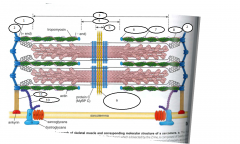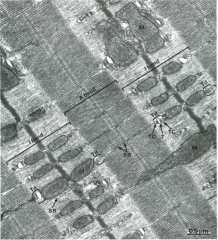![]()
![]()
![]()
Use LEFT and RIGHT arrow keys to navigate between flashcards;
Use UP and DOWN arrow keys to flip the card;
H to show hint;
A reads text to speech;
45 Cards in this Set
- Front
- Back
|
Muscle cells, called __, are elongated, arranged in parallel, and organized in ___, which is composed of many ___, which extend entire length of myofiber |
myofibers fascicles myofibrils |
|
|
Myofibrils are mostly __, which are both __ and ___ filaments that contract the muscle, and are found in the ___ |
myofilaments actin and myosin sarcoplasm |
|
|
Muscle cell development: 1. Mesenchymal cells of myotomes differentiate into mononuclear ___ and undergo ___ 2. these fuse and form ___ which are multinuclear, called a ___ 3. mature muscle cells are organized into contractile units from mytotubes, have limited proliferative capacity and are called ___ |
1. myoblasts; mitosis 2. myotubes; syncitium 3. satellite cells |
|
|
Characteristics of skeletal muscle in histo? |
elongated, unbranched, cylindrical, flattened nuclei below sarcolemma, striated |
|
|
What are the three types of striated muscle? |
skeletal muscle visceral striated muscle cardiac muscle |
|
|
What makes skeletal muscles striated? |
myofilaments (actin and myosin) are arranged in parallel and in register, creates striations seen in light microscopy |
|
|
Striated muscle: 1. I-bands are ___ in polarized light 2. A-bands are __ in polarized light 3. Z-discs is where? 4. where is nucleus? 5. myofibrils are in parallel with___ axis 6. mitochondria are in __ 7. area btwn 2 successive Z-discs is the ___, the fxnal unit of muscle contraction |
1. isotropic 2. anisotropic 3. btwn the I-bands (bisects it) 4. at periphery 5. longitudinal 6. parallel 7. sarcomere |
|
|
I-band: 1. thick or thin filament? 2. bisected by __ 3. contains actin or myosin or both? |
1. thin 2. z-disc 3. actin only (thin only) |
|
|
A-band: 1. area btwn ___ 2. contains actin or myosin or both? |
1. btwn 2 I-bands 2. both actin and mysoin (both thin and thick) |
|
|
Z-disc: scaffold for __ filaments to attach |
thin (actin) |
|
|
H-band: 1. thin or thick filament? 2. bisected by __ |
1. thick 2. M-line (only thick) |
|
|
M-line: 1. band of __ 2. keeps __ filament in place |
1. proteins 2. thick |
|
|
Organization of actin: 1. arranges in __ structure 2. positive end attaches to ___ 3. positive end has what protein to help it attach? 4. positive end gets help attaching from what? 5. negative end is capped by what protein? |
1. helical 2. z-disc 3. alpha-actinin 4. nebulin 5. tropomodulin |
|
|
F-actin (fibrous): 1. double stranded helix formed from __ 2. ___ is entwined w/in F-actin 3. it masks the ___ binding site on actin |
1. G-actin (globular) 2. tropomyosin 3. myosin |
|
|
Troponin: 1. regulates____ 2. has what 3 globular subunits? 3. what do the 3 subunits bind? |
1. tropomyosin 2. TnC, TnI, TnT 3. TnC: binds calcium TnI: binds to actin (blocks binding of actin-myosin) TnT: binds to tropomyosin, anchoring it |
|
|
Myosin in the sarcomere: 1. what is the major myosin subtype in skeletal muscle? 2. has what three areas/parts? 3. myosin head is __ that functions in the presence of bound actin 4. the coiled coil tail allows___ to pack tails together, creating _ arrangements in skeletal muscle |
1. myosin II 2. head (x2), neck (x2), tail (x2) 3. ATPase 4. myosin II; bipolar |
|
|
Accessory proteins of sarcomere: 1.___: molecular springs from z-line/disc, helps center thick filament 2.___: binds actin to z-disc 3. ___: intermediate filament that connects sarcomeres to each other around z-discs 4. ___: hold thick filaments together 5.___: links ECM to actin filaments (through dystroglycans) |
1. titin 2. alpha-actinin 3. desmin 4. M-line proteins 5. Dystrophin |
|

|
1. alpha-actin 2. Z line 3. A band 4. H band 5. M line 6. tropomodulin 7. nebulin 8. titin 9. M line proteins (mysomesin, M-protein, obscurin) 10. dystrophin 11. desmin |
|
|
1. around each A-I junction, there is a __ 2. this consists of 2 __ and 1___ |
1. triad 2. 2 terminal cisterna of sarcoplasmic reticulum and 1 T-tubule |
|
|
1. Terminal cisterna= intracellular ___ stores 2. T-tubule= invagination of ___ that localizes AP's to interior of myofiber |
1. Ca2+ 2. plasma membrane (sarcolemma) |
|

|
|
|
|
NMJ/Motor end plate organization: 1. nerve branches into axons of individual __ terminals 2. releases __ from synaptic vesicles into primary cleft and ___ of individual myofibers 3. binds postsynaptically to NAchRs, graded potential and AP follow in muscle, through__ |
1. alpha-motoneuron 2. Ach; junctional folds 3. T-tubules |
|
|
1. a single alpha-motoneuron and all the fibers it innervates is called ___ 2. increase or decrease in the number of these changes the amount of __ produced by a muscle |
1. motor unit 2. force |
|
|
1. ___ takes place at the triad through two proteins 2. when depolarized, ___ and ___ link up and allow intracellular Ca2+ to flow into the sarcoplasm |
1. excitation-contraction coupling 2. dihydropiridine receptor (DHPR) and ryanodine receptor (RYR) |
|
|
Binding of Ca2+ to troponin, moves ___, exposes __ binding site on actin |
tropomyosin myosin |
|
|
1. Once the actin binding site is free, __ can regulate the molecular event in muscle contraction 2. ___ and __ will both leave as a result of the power stroke |
1. ATP 2. ADP and Pi |
|
|
Sliding filament mechanism: 1. process by which myosin head form __ w/ actin 2. contraction does what to the two filaments? 3. the filaments do not___ however |
1. cross-bridges 2. slides the two filaments past each other 3. physically shorten |
|
|
1. Connective tissue holds muscle fibers ___ and __ together 2. this organization continues as a ___ to attach the muscle 3. lots of __ and __ supply in the connective tissue |
1. individually and collectively 2. tendon 3. blood and nerve |
|
|
What is endomysium? |
fine reticular layer surrounding a single myofiber, small blood vessels and axons in here |
|
|
What is perimysisum? |
thicker, organizes groups of myofibers, together w/ fascicles, larger blood vessels and nerves in here |
|
|
What is epimysium? |
dense connective tissue surrounding fascicles, major blood and nerve supplies found here |
|
|
Circulatory system utilizes __ pathways to supply blood to myofibers |
connective tissue |
|
|
What are the 3 varieties of skeletal muscle myofibers? |
Type I or slow twitch "A" Type II A or fast twitch oxidative/glyocyltic "I" Type II B or fast twitch glyocyltic "An" |
|
|
Type I or slow twitch "A" myofibers: 1. aerobic or anaerobic or intermediate? 2. small or large? 3. red, white, or pink muscle fibers? 4. how much tension? 5. resistant to __ 6. important for ___ 7. small or large force? |
1. aerobic 2. small 3. red 4. not much 5. fatigue 6. sustained muscle contraction (ex. regulating posture) 7. small |
|
|
Which myofiber type has the lowest threshold for activation and is therefore the first recruited? |
Type I or slow twitch "A" |
|
|
Type II A or fast twitch oxidative/glyocyltic "I": 1. aerobic or anaerobic or intermediate? 2. small or large? 3. red, white, or pink muscle fibers? 4. resistant to ___ 5. lots of ___ stored 6. how much force? |
1. intermediate 2. large 3. pink 4. fatigue 5. glycogen 6. intermediate |
|
|
Type II B or fast twitch glyocyltic "An": 1. aerobic or anaerobic or intermediate? 2. small or large? 3. red, white, or pink muscle fibers? 4. how much force? 5. not resistant to ___ 6. lots of _ stored |
1. anaerobic 2. large 3. white 4. large 5. fatigue 6. glycogen |
|
|
Which type of myofiber produces the larges lactic acid? |
Type II B or fast twitch glyocyltic "An" |
|
|
Which type of myofiber has more NMJs than others? |
Type II B or fast twitch glyocyltic "An" |
|
|
What is the order that the three myofiber types are recruited? |
Type I (first), Type II A (second), Type II B (last) |
|
|
Muscle spindles: 1. __ fibers have single row of nuclei in center of fiber 2. __ fibers have nuclei collected in bundle in center of fiber 3. of these two types, one signals ___ muscle length and one signals ___ muscle length |
1. nuclear chain 2. nuclear bag 3. static; changes in |
|
|
Type I A: 1. wraps around how many spindle types at the center of spindle? 2. has ___ endings 3. provides info on what? |
1. all 2. annulospiral 3. length and velocity |
|
|
Type II: 1. innervates nuclear chain and only ____ fibers 2. has ___ endings 3. provide info on what? |
1. static nuclear bag fibers 2. flower spray 3. length only |
|
|
Golgi tendon organs: 1. sit at ___ 2. more responsive to ___ than muscle spindles 3. use ___ axons 4. often used in __ circuits |
1. muscle-tendon junction 2. active muscle stretch 3. Ib 4. negative feedback |
|
|
1. What do extrafusal fibers do? 2. What do intrafusal fibers do? |
1. contract 2. tell brain and spinal cord the state of stretch of all the surrounding cells around it (mission control) |

